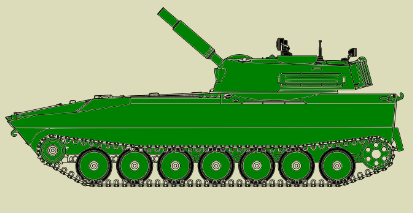2S8 Astra / Liliya - 120mm self-propelled mortar
 The self-propelled mortar itself is not new. For the first time, self-propelled mortars on the chassis of tanks and armored personnel carriers found combat use in World War II in the armies of Germany and the United States. However, the vast majority of foreign self-propelled mortars were conventional muzzle-loading field mortars with manual loading. Similar developments were carried out in the USSR since 1942. These are self-propelled mortars on a tank chassis designed by V.G. Grabin: a 107-mm ZIS-26 mortar (1942) and a 50-mm S-11 mortar (1943). However, all domestic self-propelled mortars of the 1940-1950s did not leave the stage of development work.
The self-propelled mortar itself is not new. For the first time, self-propelled mortars on the chassis of tanks and armored personnel carriers found combat use in World War II in the armies of Germany and the United States. However, the vast majority of foreign self-propelled mortars were conventional muzzle-loading field mortars with manual loading. Similar developments were carried out in the USSR since 1942. These are self-propelled mortars on a tank chassis designed by V.G. Grabin: a 107-mm ZIS-26 mortar (1942) and a 50-mm S-11 mortar (1943). However, all domestic self-propelled mortars of the 1940-1950s did not leave the stage of development work.
One of the reasons for the resumption of work on the 120-mm self-propelled mortar in the mid-1960s was the expansion of the range of tasks facing the Airborne Forces. Thus, plans were developed for the preemptive landing of our airborne group in the "Palatinate Triangle" (the territory of the Federal Republic of Germany at the junction of the borders with France and the Netherlands). It was in this area that the weapons of all American divisions deployed in the European theater of operations during the "threatened period" were stored.
But in this case, Soviet airborne forces could face the opposition of two or even three divisions of the Bundeswehr "second order". Therefore, it became obvious that the ground striking force of the airborne division on the BMD should be of the same order of magnitude as the striking force of the motorized rifle division on the BMP.
The Soviet Airborne Forces had self-propelled 85-mm ASU-85, as well as towed guns - an 85-mm D-48 cannon and a 122-mm D-30 howitzer. But the firepower of the ASU-85 was already insufficient, and the speed of the towed artillery column was almost 1.5 times less than that of the tracked self-propelled guns columns.
Therefore, in 1965, VNII-100 developed two options for installing a 120-mm mortar with ballistics and ammunition for the M-120 mortar. In the first version, the mortar was installed in a combat vehicle on the chassis of the MT-LB tractor ("object 6"). M-120 mortar on a standard carriage was placed in the rear of the combat vehicle. The mortar was loaded from the muzzle. The angle of vertical guidance of the mortar from + 45 ° to + 80 °; horizontal guidance angle 40 °. Ammunition - 64 mines. Rate of fire up to 10 rds / min. Additional armament: 7.62 mm PKT machine gun. Crew of 5 people.
In the second version, a 120-mm breech-loading mortar with a revolving mine feed was used (drum capacity - 6 minutes). The mortar was located in the turret and turret compartment of the BMP-1 ("object 765"). The combat weight of the mortar was to be 12.34 tons. The vertical guidance angle of the mortar was from + 35° to + 80°; horizontal guidance angle 360??°. Ammunition - 80 min. Additional armament: 7.62 mm PKT machine gun. Crew of 5 people.
Both versions of VNII-100 remained on paper.
On September 13, 1969, the Commission on Military-Industrial Issues (VPV) under the USSR Council of Ministers instructed the TCM Design Bureau of the Minoshemash (G-4882 enterprise) to develop a project for two self-propelled 120-mm mortars with M-120 ballistics. The swinging part of both mortars is designed according to the barrel rollback scheme, with recoil devices and with a longitudinally sliding piston breech. The mortar had a hydropneumatic rammer of mines, powered by the energy of a hydropneumatic accumulator, which was charged when reeling. Mortars could fire all standard 120-mm mines, as well as a new active-reactive mine (AWP).
The first version of the 120-mm self-propelled mortar was named "Astra" and index 2S8; the second is the name "Lily of the Valley" [Ru = Liliya dolina]. "Astra" was intended for the ground forces, and "Lily of the valley" - for the airborne troops. The Astra mortar was created on the chassis of the serial 122-mm self-propelled howitzer 2 C1 "Gvozdika". The mortar was located in the turret and had a circular fire. The swinging part of the mortar is installed in the trunnion sockets from the 2 A31 howitzer. To reduce the gas content of the fighting compartment, the mortar is equipped with a channel blowing system (ejector).
The 120-mm self-propelled mortar "Lily of the valley" was created on the chassis of the experienced 122-mm self-propelled howitzer 2S2 "Violet" ("object 924"). The mortar is located in the wheelhouse of the self-propelled unit. The swinging part of the mortar is installed in the trunnion sockets from the 2 A32 howitzer. In the project, in comparison with the tactical and technical requirements for the Lily of the Valley, the horizontal guidance angle was reduced from 30° to 20°, and there was no 12.7-mm Utes machine gun.
On its own initiative, KB TChM presented a variant of installing a standard 120-mm mortar M-120 on the chassis of the MT-LB tractor. The standard M-120 mortar was retrofitted with a damper device and installed on a pedestal with a ball shoulder strap. If necessary, the mortar could be easily removed from the pedestal and installed on a plate (standard from M-120) for firing from the ground. In the usual position, the plate was hung on the rear of the chassis.
|
NEWSLETTER
|
| Join the GlobalSecurity.org mailing list |
|
|
|

